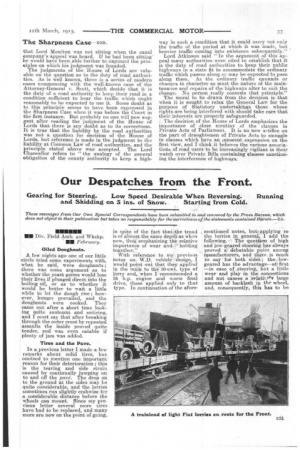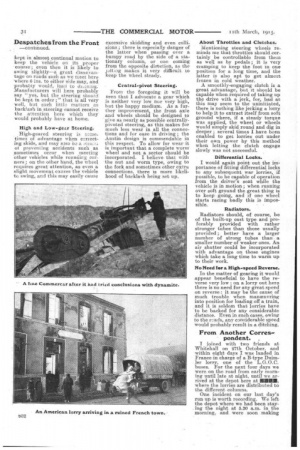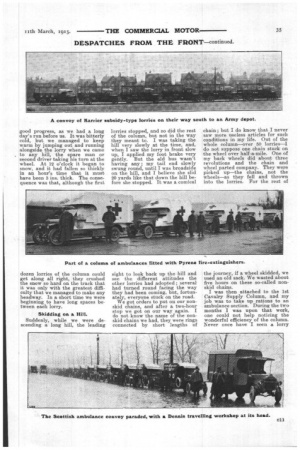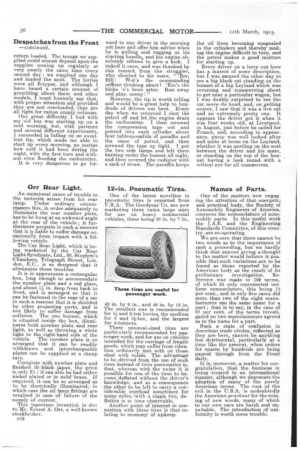Our Despatches from the Front.
Page 14

Page 15

Page 16

Page 17

If you've noticed an error in this article please click here to report it so we can fix it.
Gearing for Steering. Low Speed Desirable When Reversing. Running and Skidding on 3 ins. of Show. Starting from Cold.
A few nights ago one of our little circle tried some experiments with, what he said, were doughnuts there was some argument as to; whether the yeast germs would lose their lives if plunged direct into the boiling oil, or as to whether it would be better to wait a little while to let the dough rise however, hunger prevailed, and the doughnuts . were cooked, They came out after a short time looking quite sunburnt and enticing, and I must say that after breaking through the outer crust by repeated assaults the inside proved quite tender, and was even eatable if plenty of jam was added.
Tires and the Pave, In a previous letter I made a few remarks about solid tires, but omitted to mention one important. reason for their deterioration ; this is the tearing and side strain caused by continually jumping on to and off the pave. The drop on to the ground at the sides may he quite considerable, and the lorries sometimes run slightly crabwise for a considerable distance before the wheels can mount. Since my previous letter several more tires have had to be replaced, and many more are now on the point of going, in spite of the fact thatathe tread is of almost the same depth as when new, thug emphasizing the relative importance of wear and' holding together."
With reference -to my . previous not-es on W.D. vehicle:7deeign, I would point out that they applied in the main to the: 30-cwt. type of larry and,..when I recommended a 35 h.p. engine and worm final drive, these applied only to that type. In continuation of the afore mentioned notes, but, applying to the lorries in general, I add the following. The question of high and low-geared steering healways proved a debatablepoint a,mong raanufactiirers, and there is much to say for both Sides:; theelowgeared has the advantage—at-first —in ease of steering, but a little wear and play in the -connections and nut camas a 'relatit.elv large amount of backlash in the wheel, and, consequently, this has to be kept in almost continual motion to keep the vehicle on its proper course ; even then it is likely to swing slightly—a great disaavantage on road's such as we meet here .where.6 ins, to either side May, and -probably would, lead to dlLennig. Manufacturers will here probably say ".yes, but the steering should be kept in order ; " that is all very well, but such little matters as backlash in steering -cannot receive the attention here which they would probably have at home.
High and Low-gear Steering.
. High-geared steering is sometimes of advantage When c.orrecting skids, and may also be a inektli of preventing accidents such as sometimes occur when meeting 'ether vehicles while rounding corners ; on the other hand, the wheel requires great attention, as even a slight movement causes the vehicle to swing, and this may easily cause excessive skidding and even collisions; there is especially danger of the latter when passing over a bumpy road by the side of a stationary column, or one coming from the opposite dirtction, as the j.tltLig makes it very difficult to keep the wheel steady.
Central-pivot Steering.
From the foregoing it will be seen that I advocate a gear which is neither very low nor very high, but the happy medium. As a further improvement, the front axle and wheels should be designed to give as nearly as possible centrallypivoted steering, as this makes for much less wear in all the connections and for ease in driving ; the Austin design is commendable in this respect. To allow for wear it is important that a complete worm wheel and not a sector should be incorporated. I believe that with the nut and worm type, owing to the fork and sometimes other extra connections, there is more likelihood of backlash being set up. About Throttles and Clutches.
Mentioning steering wheels reminds me that throttles should certainly be controllable from them as well as by pedals ; it is very cramping to keep the foot in one position for a long time, and the latter is also apt to get alrocczt frozen in cold weather.
A smoothly-engaging clutch is a great advantage, but it should be capable when required of taking up the drive with a jerk, for, bad ac this may seem to the uninitiated, there is nothing like jerking a lorry to help it to extract itself from soft ground where, if a steady torque was applied, the wheel or wheels would simply skid round and dig in deeper ; several times I have been enabled to get lorries out under their own power by this method when letting the clutch engage slowly was not successful.
Differential Locks.
would again point out the importance of fitting differential locks to any subsequent war lorries, if possible, to be capable of operation from the driver's seat while the vehicle is in motion ; when running over soft ground the great thing is to keep going, and if one wheel starts racing badly this is impossible.
Radiators.
Radiators should, of course, be of the built-up oast type and preferably provided with rather stronger tubes than those usually provided ; better have a larger number of strong tubes than a smaller number of weaker ones. An air shutter could be incorporated with advantage on those engines which take a long time to warm up to their work.
No Need for a High-speed Reverse.
In the matter of gearing it would appear beneficial to have the reverse very low ; on a lorry out here there is no need for any great speed on reverse it may he the cause of much trouble when manoeuvring into position for loading off a train, and it is seldom that lorries have to be backed for any considerable distance. Even in such cases, owing to the roads, any considerable speed would probably result in a ditching.
From Another Correspondent. ,
I joined with two friends at Whitehall on 27th October, and within eight days I was landed in France in charge of a B-type Daimler lorry, one of the L.G.O.O. buses. For the next four days we were on the road from early morning until late at night, until we arrived at the depot here at NOM where the lorries are distributed to the different columns.
One incident on our last day's run up is worth recording. We left the depot where we had been stay. ing the night at 5.M a.m. in the morning, and were soon making
good progress, as we had a long day's run before us. It was bitterly cold, but we managed to keep warm by jumping out and running alongside the lorry when we came to any hill, the spare man or second driver taking his turn at the wheel. At 12 o'clock it began to snow, and it had fallen so thickly in an hour's time that it must have been 3 ins. thick. The consequence was that, although the first lorries stopped, and so did the rest of the column, but not in the way they meant to. I was taking the hill very slowly at the time, and, when I saw the lorry in front slow up, I applied my foot brake very gently. But the old bus wasn't having any ; my tail end slowly swung round, until I was broadside on the hill, and T believe she slid 20 yards like that down the hill before she stopped. It was a comical
chain ; but I do know that I never saw more useless articles for such conditions in my life. Out of the whole column—over 50 lorries—I do not suppose one chain stuck on the wheel over half-a-mile. One of my back wheels did about three revolutions and the chain, and wheel parted company. They were picked up—the chains, not the wheels—as they fell and thrown into the lorries. For the rest of
dozen lorries of the column could get along all right, they crushed the snow so hard on the track that it was only with the greatest difficulty that we managed to make any headway. In a short time we were beginning to have long spaces between each lorry.
Skidding on a Hill.
Suddenly, while we were descending a long hill, the leading
sight to look back up the hill and see the different attitudes the other lorries had adopted; several had turned round facing the way they had been coming, but, fortunately, everyone stuck on the road. We got orders to put on our nonskid chains, and after a two-hour stop we got on our way again. I do not know the name of the nonskid chains we had, they were rings connected by short lengths of
the journey, if a wheel skidded, we used an old sack. We wasted about five hours on these so-called nonskid chains.
I was then attached to the Tat Cavalry Supply Column, and my job was to take up rations to an ambulance section. During the two months I was upon that work, one could not help noticing the wonderful efficiency of the column. Never once have I seen a lorry return loaded. The troops we supplied could almost depend upon the supplies coming up regularly at very nearly the same time every second day ; we supplied one day and loaded the next. The lorries were all B-types, and although I have heard a certain amount of grumbling about these and other models, 1. must honestly say that, with proper attention and provided they are not overloaded, they are all right for ration supply columns. One great difficulty I had with my old bus was starting up on a cold morning, but, with patience and several different experiments, I succeeded in falling on an excellent tip, which made me able to start up every morning, no matter how cold it had been during the night, with the first turn and without even flooding the carburetter.
It is very dangerous to go for ward to any driver in the morning out here and offer him advice when he is pulling and tugging at his starting handles and his engine absolutely refuses to give a kick. I risked it once, and was thanked by this remark from the struggler, who shouted to his mate, Bill! Wot's the commanding orffiser thinking abaft? 'Ere's the bloke 'e's been arter. Run away and play, sonny! "
However, the tip is worth telling and would be a great help to hundreds of drivers out here. Every day when we returned I shut the petrol off and letathe engine drain the carburetter. I then screwed the compression taps out and poured into each cylinder about four tablespoonfuls of paraffin and the same of petrol, and then screwed the taps up tight. I put the two side lamps and left them burning under the bonnet all night, and then covered the radiator with a sack of straw. The paraffin keeps the oil from becoming congealed in the cylinders and thereby making the engine difficult to turn, and the petrol makes a good mixture for starting up.
Every driver on a lorry out here has a mascot of some description, but I was amused the other day to see a big black cat standing on the bonnet of a big Leyland which was reversing and manceuvring about to get near a particular wagon, but I was doubly surprised to see the cat move its head, and, on getting nearer, I saw that it was a live cat and an extremely pretty one. It appears the driver got it when it was four weeks old, at Liverpool, in August, just before he sailed for France, and, according to appearance, pussy was well looked after and quite at home on the Leyland, whether it was nestling on the seat between the driver and his mate, or standing on the top of the bonnet having a look round with a critical eye for all manceuvres.





















